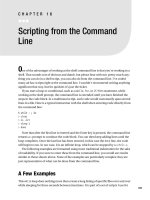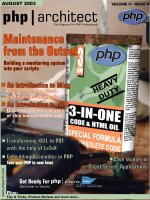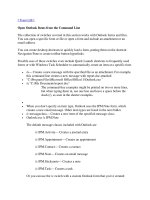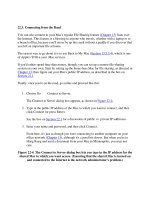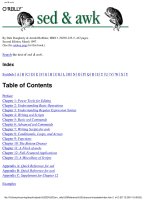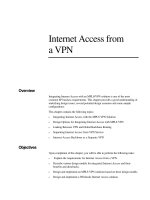Lean from the Trenches doc
Bạn đang xem bản rút gọn của tài liệu. Xem và tải ngay bản đầy đủ của tài liệu tại đây (12.47 MB, 165 trang )
www.it-ebooks.info
What Readers Are Saying About Lean from the Trenches
FANTASTIC! I know it’s going to make a big dent in the world of software develop-
ment. It’s easily the most important book I have seen in the past year!
➤
Mary Poppendieck, Author of the Lean Software Development series
I read the whole thing end to end. In a word, FANTASTIC! Grounded, real, funny,
easy to read, smooth flow, good balance between theory and practice.
➤
Kent Beck
Awesome. Kudos to you for documenting the everyday sort of decision making
that has to happen for a big project to be successful. I hope it becomes a bench-
mark against which many more projects are judged.
➤
Ward Cunningham
I could not stop reading Lean from the Trenches. This book shows me that a big
project can be run in a lean and agile way. For people in the trenches of large
enterprises, stories like this make a huge difference.
➤
Yves Hanoulle, Change Artist at PairCoaching.net
www.it-ebooks.info
An excellent peek into a pragmatic application of the best of the agile processes
in a real-world scenario. If you ever wondered “Am I doing it right?” then this book
may just provide you with the answer. Every technical team lead interested in
seeing how an agile process actually works should buy this now!
➤
Colin Yates, Principle Engineer, QFI Consulting LLP, UK
It rocks. Finally, a nonpuritan, pragmatic, successful case study with real, usable
ideas.
➤
Simon Cromarty, The Agile Pirate
I really enjoyed this immensely pragmatic and readable look at a real project
organized on agile and lean principles. The emphasis on real-life experiences
rather than theory was refreshing and engaging. I will definitely recommend this
book to friends and will use its insights in my own professional engagements.
➤
Kevin Beam, Independent Software Developer, Lambda42, LLC
www.it-ebooks.info
Lean from the Trenches
Managing Large-Scale Projects with Kanban
Henrik Kniberg
The Pragmatic Bookshelf
Dallas, Texas • Raleigh, North Carolina
www.it-ebooks.info
Many of the designations used by manufacturers and sellers to distinguish their products
are claimed as trademarks. Where those designations appear in this book, and The Pragmatic
Programmers, LLC was aware of a trademark claim, the designations have been printed in
initial capital letters or in all capitals. The Pragmatic Starter Kit, The Pragmatic Programmer,
Pragmatic Programming, Pragmatic Bookshelf, PragProg and the linking g device are trade-
marks of The Pragmatic Programmers, LLC.
Every precaution was taken in the preparation of this book. However, the publisher assumes
no responsibility for errors or omissions, or for damages that may result from the use of
information (including program listings) contained herein.
Our Pragmatic courses, workshops, and other products can help you and your team create
better software and have more fun. For more information, as well as the latest Pragmatic
titles, please visit us at
.
The team that produced this book includes:
Kay Keppler (editor)
Potomac Indexing, LLC (indexer)
Kim Wimpsett (copyeditor)
David J Kelly (typesetter)
Janet Furlow (producer)
Juliet Benda (rights)
Ellie Callahan (support)
Copyright © 2011 The Pragmatic Programmers, LLC.
All rights reserved.
No part of this publication may be reproduced, stored in a retrieval system, or
tra ns mi tt ed, i n any form , or by an y mea ns , ele ct ro ni c, me ch an ic al, p ho to co pying,
recording, or otherwise, without the prior consent of the publisher.
Printed in the United States of America.
ISBN-13: 978-1-934356-85-2
Printed on acid-free paper.
Book version: P1.0—December, 2011
www.it-ebooks.info
Contents
Foreword . . . . . . . . . . . . . xi
Preface . . . . . . . . . . . . . . xiii
Part I — How We Work
1. About the Project . . . . . . . . . . . . 3
1.1 Timeline 5
1.2 How We Sliced the Elephant 6
1.3 How We Involved the Customer 7
2. Structuring the Teams . . . . . . . . . . 9
3. Attending the Daily Cocktail Party . . . . . . . 13
3.1 First Tier: Feature Team Daily Stand-up 14
3.2 Second Tier: Sync Meetings per Specialty 15
3.3 Third Tier: Project Sync Meeting 16
4. The Project Board . . . . . . . . . . . 19
4.1 Our Cadences 22
4.2 How We Handle Urgent Issues and Impediments 23
5. Scaling the Kanban Boards . . . . . . . . . 27
6. Tracking the High-Level Goal . . . . . . . . 31
7. Defining Ready and Done . . . . . . . . . 35
7.1 Ready for Development 36
7.2 Ready for System Test 37
7.3 How This Improved Collaboration 38
www.it-ebooks.info
8. Handling Tech Stories . . . . . . . . . . 39
8.1 Example 1: System Test Bottleneck 40
8.2 Example 2: Day Before the Release 41
8.3 Example 3: The 7-Meter Class 42
9. Handling Bugs . . . . . . . . . . . . 45
Continuous System Test 459.1
9.2 Fix the Bugs Immediately! 46
9.3 Why We Limit the Number of Bugs in the Bug Tracker 47
9.4 Visualizing Bugs 48
9.5 Preventing Recurring Bugs 50
10. Continuously Improving the Process . . . . . . 53
10.1 Team Retrospectives 54
10.2 Process Improvement Workshops 54
10.3 Managing the Rate of Change 62
11. Managing Work in Progress . . . . . . . . . 65
11.1 Using WIP Limits 69
11.2 Why WIP Limits Apply Only to Features 70
12. Capturing and Using Process Metrics . . . . . . 73
Velocity (Features per Week) 7312.1
12.2 Why We Don’t Use Story Points 75
12.3 Cycle Time (Weeks per Feature) 76
12.4 Cumulative Flow 81
12.5 Process Cycle Efficiency 83
13. Planning the Sprint and Release . . . . . . . . 85
Backlog Grooming 8513.1
13.2 Selecting the Top Ten Features 86
13.3 Why We Moved Backlog Grooming Out of the Sprint
Planning Meeting 86
13.4 Planning the Release 87
14. How We Do Version Control . . . . . . . . . 89
14.1 No Junk on the Trunk 90
14.2 Team Branches 91
14.3 System Test Branch 92
15. Why We Use Only Physical Kanban Boards . . . . . 95
Contents • vii
www.it-ebooks.info
16. What We Learned . . . . . . . . . . . 99
Know Your Goal 9916.1
16.2 Experiment 99
16.3 Embrace Failure 99
16.4 Solve Real Problems 100
16.5 Have Dedicated Change Agents 100
16.6 Involve People 100
Part II — A Closer Look at the Techniques
17. Agile and Lean in a Nutshell . . . . . . . . 103
Agile in a Nutshell 10417.1
17.2 Lean in a Nutshell 106
17.3 Scrum in a Nutshell 109
17.4 XP in a Nutshell 111
17.5 Kanban in a Nutshell 112
18. Reducing the Test Automation Backlog . . . . . . 117
What to Do About It 11718.1
18.2 How to Improve Test Coverage a Little Bit Each
Iteration 118
18.3 Step 1: List Your Test Cases 118
18.4 Step 2: Classify Each Test 119
18.5 Step 3: Sort the List in Priority Order 120
18.6 Step 4: Automate a Few Tests Each Iteration 122
18.7 Does This Solve the Problem? 123
19. Sizing the Backlog with Planning Poker . . . . . 125
19.1 Estimating Without Planning Poker 125
19.2 Estimating with Planning Poker 127
19.3 Special Cards 128
20. Cause-Effect Diagrams . . . . . . . . . . 131
Solve Problems, Not Symptoms 13120.1
20.2 The Lean Problem-Solving Approach: A3 Thinking 132
20.3 How to Use Cause-Effect Diagrams 133
20.4 Example 1: Long Release Cycle 134
20.5 Example 2: Defects Released to Production 138
20.6 Example 3: Lack of Pair Programming 140
20.7 Example 4: Lots of Problems 144
Contents • viii
www.it-ebooks.info
20.8 Practical Issues: How to Create and Maintain the
Diagrams 145
20.9 Pitfalls 146
2 0 . 1 0 Why Use Cause-Effect Diagrams? 147
21. Final Words . . . . . . . . . . . . 149
A1. Glossary: How We Avoid Buzzword Bingo . . . . . 151
Index . . . . . . . . . . . . . . 153
ix • Contents
www.it-ebooks.info
Foreword
We who give project advice are faced with a mighty temptation. The teams
who engage us are looking for direction, hope, ideas, energy, and guidance
(and sometimes someone to blame, but that’s a different topic). We are called
in because we have been in a variety of situations, some more functional and
some less. We try to help our clients move toward “more functional.” However,
we are often as baffled as they about what to do next.
The temptation I am referring to is the temptation to begin speaking beyond
our experience, to meet the client’s need for certainty by manufacturing a
certainty we ourselves do not feel. Left untreated, this results in dogma,
revealed by words like “must,” “always,” and “everybody.”
One beauty of this book’s story is its complete lack of dogma. It is a story. A
story of a project that had real troubles and addressed them with a small set
of easily understood practices. Applying those practices required wisdom,
patience, and persistence, which is why you can’t just copy the story to fix
your project.
The other reason you can’t just copy the story is because it isn’t written as a
general prescription. It is a particular team in a particular culture with a
particular client. You are going to have to work to apply it to your situation,
but that’s good, because you are in any case going to have to work to encour-
age any change.
There are general principles at work here. I’ve been fortunate enough to work
with Henrik a bit, and he told me he really has only one trick: make all the
important information visible in one place and then decide what to do together.
If that’s his only trick (and I have my doubts), it’s a good one.
www.it-ebooks.info
Society has learned to distrust us for our big, complicated, and ultimately
futile public software projects. This is the story of a public service project that
managed to serve the public. What it takes to regain the public’s trust
is teamwork, transparency, and early and frequent releases. Oops, I just
succumbed to that temptation I just warned you about. You’d better just read
the story and learn your own lessons.
Kent Beck
September 2011
xii • Foreword
www.it-ebooks.info
Preface
Many of us have heard about Lean software development, Kanban, and other
trendy buzzwords. But what does this stuff actually look like in practice? And
how does it scale to a 60-person project developing a really complex system?
I can’t tell you how to do it, since every context is different. But I will tell you
how we’ve been doing it (basically a Scrum-XP-Kanban hybrid), and maybe
some of our solutions and lessons learned can be valuable in your context.
Who This Book Is For
This book is primarily written for team leads, managers, coaches, and other
change agents within software development organizations.
However, some parts will probably be useful to anyone interested in software
development, Lean product development, or collaboration techniques in gen-
eral—regardless of role or industry.
For those who want to comment, go to the book’s main page,
1
and from there
you can reach the forum and errata pages. I welcome your comments!
How to Read This Book
This book is divided in two parts, each subdivided into several short chapters.
Part I, “How We Work,” is a case study showing how Kanban and Lean prin-
ciples were applied in a large project for the Swedish police. The first chapter
describes what the project was about, and the subsequent chapters describe
specific challenges (such as scaling), how we dealt with those challenges, and
what we learned along the way.
Part II, “A Closer Look at the Techniques,” starts with a high-level introduction
to Agile and Lean and then expands on some of the practices mentioned in
Part I, such as cause-effect diagrams.
1. />
www.it-ebooks.info
I suggest you read Part I end to end, since that is the heart of this book, and
the chapters build upon each other. Then you can cherry-pick from Part II,
since those chapters are independent.
New to Agile or Lean?
If you are new to Agile or Lean, don’t worry. This book is all about practice,
not theory. I’ll simply show you what we’ve been doing, and you’ll pick up
most of the theory along the way.
If you prefer to start with a high-level overview of Agile and Lean and the
associated methods Scrum, XP, and Kanban, then go ahead and jump to
Chapter 17, Agile and Lean in a Nutshell, on page 103.
Disclaimer
I don’t claim that our way of working is perfectly Lean. Lean is a direction,
not a place. It’s all about continuous improvement. Lean has no clear defini-
tion, but many of the practices that we apply are based on the principles of
Lean product development that Mary Poppendieck, David Anderson, and Don
Reinertsen teach. And these practices, by the way, happen to match Agile
principles quite well on most counts.
Another thing—you will see this project from my perspective, a part-time
coach during six months of this project. My goal is not to present a 100 percent
complete picture; I’ll just give you a general idea of what we’ve been doing
and what we’ve learned so far.
Acknowledgments
Many people have contributed to this book—thanks to you all! I’d especially
like to thank Håkan Rydman for being the internal change agent and getting
me into this project, and Tomas Alsterlund for providing strong management
support and keeping us focused on the project goal.
And I’d also like to call out the following people:
Christian Stuart and the rest of the RPS management team for entrusting
me to coach this project and allowing us to spread the word about what we’ve
been doing.
All project participants for putting their hearts into this project and helping
to drive the change process. I was amazed by the skill, creativity, and energy
of this project team!
Mary and Tom Poppendieck for years of personal mentorship and cotraining
in Lean software development and for encouraging me to write this book.
xiv • Preface
www.it-ebooks.info
They also kindly contributed most of the content in Section 17.2, Lean in a
Nutshell, on page 106.
My editor, Kay Keppler. I’ve never worked with an editor before, and I was
surprised about how valuable this was. Kay not only improved the book, she
helped me become a better writer!
All reviewers: Gunnar Ahlberg, Kevin Beam, Kent Beck, Pawel Brodzinski,
Ward Cunningham, Doug Daniels, Chad Dumler-Montplaisir, Yves Hanoulle,
Michael Hunter, Andy Keffalas, Maurice Kelly, Sebastian Lang, Rasmus
Larsson, Mary Poppendieck, Sam Rose, Daniel Teng, Nancy Van Schooender-
woert, Joshua White, and Colin Yates.
Martie Smith and Emma Mattsson for donating some great photographs.
Finally, my wife, Sophia, for granting me focus and flow (not easy with four
small kids in the house…) so that I could finish the first draft of this book
within days instead of months.
Henrik Kniberg
mailto:
Stockholm, October 2011
Acknowledgments • xv
www.it-ebooks.info
Part I
How We Work
Let’s climb into the trenches and take a look at
what this project is about and how things get done.
www.it-ebooks.info
CHAPTER 1
About the Project
RPS (“rikspolisstyrelsen”) is the Swedish national police authority, and the
product we have built is a new digital investigation system called PUST
(“Polisens mobila Utrednings STöd”). The basic idea is to equip every police
car with a small laptop, a mobile Internet connection, and a web application
that allows officers to handle all the investigation work quickly.
Suppose an officer catches a drunk driver. In the past, the officer would have
had to capture all the information on paper, drive to the station, file a report,
and then hand the case over to another investigator for further work. This
would take a month or so.
With PUST, the officer captures all the information directly on the laptop,
which is online and integrated directly with all relevant systems. The case is
closed within a few days or even hours.
www.it-ebooks.info
The system was rolled out nationwide in April 2011 and garnered quite a lot
of media attention. The product has been featured in major newspapers, on
TV, and on the radio, and so far the response has been very positive.
1
Petty crimes are now processed, on average, six times faster,
2
and the police
can spend more time in the field and less time at the station. More crimes
can be resolved and with higher quality, which is likely to improve crime
statistics over the long term. Staying in the field is also more motivating for
the officers. Police like to do police work, not paperwork!
Furthermore, the project itself has gone well. We’ve had surprisingly few
support issues and bug reports, compared to past projects of similar complex-
ity and scale. PUST is a complicated system because it has to do the following:
• Integrate with a huge number of legacy systems
• Be very user friendly since police will be using the system in real time
while doing interrogations
• Be highly secure
• Comply with a lot of complicated laws and regulations
This project was very important to RPS. In fact, the Minister for Justice had
declared publicly that the primary focus of the Swedish police was to become
more effective and reduce the processing time for investigations. The high
stakes, complex technology, and aggressive timeline made it clear that we
probably couldn’t pull off this project using traditional methods. We were
1. www.dn.se/nyheter/sverige/polisen-utreder-betydligt-snabbare-med-ny-metod
2. www.polisen.se/sv/Aktuellt/Nyheter/Gemensam/2011/april-juni/Snabbare-
brottsutredningar-med-PUST/
4 • Chapter 1. About the Project
www.it-ebooks.info
therefore allowed to explore new and more effective ways of working, which
is what this book is about.
PUST is part of a cultural change within RPS, a nationwide Lean initiative
throughout the whole organization. So, it made a lot of sense to start applying
Lean principles to the development process itself too!
1.1 Timeline
The goal of the project was to make the PUST system available to all police
in Sweden by early 2011. Development started around September 2009. The
first release to production (a pilot) happened one year later, followed by a series
of bimonthly follow-up releases.
Q3 Q4 Q3 Q4 Q1 Q2 Q1 Q2
2009 2010 2011
1.0 1.1 1.2 1.3 1.4 1.5
Project Launch
10 People
30 People
60+ People
First Pilot
Release
Nationwide
R e l e a s e
The project size was initially about ten people in Q3 2009, scaled to about
thirty people in mid-2010, and then doubled to sixty-plus people in Q4 2010.
The key milestones were 1.0 (the first pilot release to real users) and 1.4 (the
nationwide release). The system will, of course, continue to evolve over many
years, so 1.4 is by no means the last release.
One year to first release might seem like a long time to Agile folks, but com-
pared to other government projects of similar scope and complexity, this was
extremely short! Some of these types of projects have taken up to seven years
until first release! Release to production every second month is also quite an
unusual concept. Many government organizations release only once or twice
per year. We’re hoping to reduce this even further to a monthly release cycle.
All these factors—the short release cycles and the aggressive scaling—drove
the need to evolve the organization and development process quickly.
And that’s how I got involved as coach.
I was on the project from December 2010 to June 2011, working roughly two
to three days per week. My main focus was on putting Lean and Agile princi-
ples into practice and helping the teams evolve just the right process for their
Timeline • 5
www.it-ebooks.info
Joe asks:
Why Release Often? Isn’t That Expensive?
Well, yes, each release does carry a fixed cost. But the release is the moment of truth
—the only time that we really learn about how our product fits the user’s needs! The
longer we wait between releases, the more bugs and incorrect assumptions we will
embed in the code. Also, with smaller and more frequent releases, the pain and risk
for each release is reduced.
context. That’s what the rest of this book is about—what we did, what
problems we encountered, how we dealt with them, and what we learned. It
was a challenging but fun journey!
One thing to keep in mind, though
This book is basically a snapshot of how our process looked in June 2011.
One of the most important characteristics of a Lean process is that it keeps
evolving. Sometimes we find better solutions. Sometimes a seemingly great
solution yesterday causes a new problem today. Sometimes our environment
and circumstances change, forcing us to adapt.
So, by the time you read this book, the project may well look very different.
1.2 How We Sliced the Elephant
The key to minimizing risk in large projects is to find a way to “slice the ele-
phant,” that is, find a way to release the system in small increments instead
of saving up for a big-bang release at the end. Ideally, each increment should
independently add value to the users and knowledge to the teams.
We sliced this elephant across two dimensions: geographic location and type
of crime.
1.0
1.2
1.3
1.4
1.5
Region
Östergötland,
Uppsala, etc
Crime Types
(Weapon
Possession,
Drunk Driving,
Shoplifting, etc)
Integrations
1.1
etc
6 • Chapter 1. About the Project
www.it-ebooks.info
• Release 1.0-1.2: Pilot releases to only one region—Östergötland—support-
ing only a small number of common crime types such as drunk driving
and weapon possession. Other crime types were handled the old manual
way. For each subsequent release we improved the stability and added
more crime types.
• Release 1.3: Expanded the release to a second region—Uppsala.
• Release 1.4: Expanded the release to the rest of Sweden. This was the
“main” release.
• R el ea se 1. 5: A dd itional crime types added, with new in tegrations to various
systems such as tracking of confiscated goods.
In addition to the bimonthly feature releases, we made small “patch” releases
every few weeks to provide bug fixes and minor improvements to existing
functionality.
1.3 How We Involved the Customer
PUST was an in-house project; the customer, users, and developers were all
part of the Swedish police organization.
PUST Project
Customer
Acceptance Test
User Group
On-Site
User
Pilot Users
One person acted as the main “customer” (or “buyer”) to the project. She had
a list of features at a pretty high level. We called them feature areas, which
roughly equates to what agile folks would call epics. This list was used for
high-level scheduling and release planning.
How We Involved the Customer • 7
www.it-ebooks.info
In addition to the customer, there was an on-site user in the building with
the development teams. The on-site users were there to give detailed feedback,
see demos, answer questions from developers, and so on. Initially we had
on-site users only once per week or so, but during later stages we had on-site
users almost every day, through a rotating schedule.
A week before each release we had an acceptance test group come in, typically
ten or so police officers, investigators, and other real users. This group would
spend a couple of days trying the latest release candidate and giving feedback.
Usually the system worked quite well by the time it reached acceptance test,
so we rarely had any nasty surprises coming up at that point.
As soon as the first release was out the door, we had a group of pilot users
in Östergötland (a region in southern part of Sweden) hard at work, giving us
a continuous stream of feedback on our efforts.
8 • Chapter 1. About the Project
www.it-ebooks.info
CHAPTER 2
Structuring the Teams
One of the key challenges in software projects is how to organize people into
decently sized teams and then how to coordinate between multiple teams.
As we scaled from thirty to sixty-plus people, we started running into serious
communication and coordination difficulties—typical symptoms of growth
pain. Fortunately, we were all located on the same floor; everybody in the
project was within at most thirty seconds’ walking distance from each other.
As a result, we could quite easily experiment with how to organize the project.
In fact, collocation may well have been the most important success factor of
this project.
We gradually evolved the team structure to something like this:
Three
Feature Teams
System Test
T e a m
Requirements
Analyst
T e a m
www.it-ebooks.info
We have five teams: one requirements team, three feature development teams,
and one system test team. Some people are outside of the team structure to
handle specialist functions and coordination functions. This includes the
project manager, project administrator, configuration manager, e-learning
specialist, performance test expert, development manager, coach, and so on.
The three feature teams are basically Scrum teams; that is, each team is
collocated, cross-functional, self-organized, and capable of developing and
testing a whole feature. For more info on Scrum, see Section 17.3, Scrum in
a Nutshell, on page 109.
The requirements analyst team is essentially a virtual team, so instead of
sitting together as a team, they are spread around to ensure that everyone
on the project has close access to a requirements analyst. Within this team
are essentially three subroles:
• Some analysts are embedded in one of the feature teams and follow that
team’s features all the way through development into test, answering
questions and clarifying the requirements along the way.
• Some analysts focus on the “big picture” and aren’t embedded in any
feature team. They look further into the future to define high-level feature
areas.
• The rest of the members of the analyst team are flexible and move between
the two other subroles depending on where they are needed most at the
moment.
The test team follows a similar virtual team structure, with corresponding
subroles:
• Some testers are embedded in a feature team and help that team get their
software tested and debugged at a feature level.
• Some testers are “big-picture” testers and focus on doing high-level system
tests and integration tests on release candidates as they come out. The
person coordinating that work is informally called the system test general.
• The rest of the test team members are flexible and move between the
other two roles as needed.
In the past, the teams were organized by specialty. We had a distinct require-
ments team, a distinct test team, and distinct development teams that did
not have embedded testers or analysts. That didn’t scale very well, because
as more people were added to the project, communication problems developed.
Teams tended to communicate with other teams through documents rather
10 • Chapter 2. Structuring the Teams
www.it-ebooks.info
than talking, and they tended to blame problems on each other. Teams also
tended to focus on getting their part of the work done instead of the whole
product. For example, a requirements analyst would consider his work for a
feature “done” when the requirements document had been written and signed
off, instead of staying with that feature all the way through to production.
The level of collaboration improved dramatically as we evolved to a more
Scrum-like structure, with cross-functional teams of analysts, testers, and
developers sitting together. We didn’t go “all the way,” though; we kept some
analysts and testers outside of the feature teams so they could focus on the
“big picture” instead of individual features. This scaled quite nicely and gave
us a good balance between short-term feature focus and long-term product
focus.
Chapter 2. Structuring the Teams • 11
www.it-ebooks.info
CHAPTER 3
Attending the Daily Cocktail Party
If you walk into this project on any day before 10:15 a.m., it will feel like
walking into a cocktail party! People are everywhere, standing in small groups
and communicating.
www.it-ebooks.info

